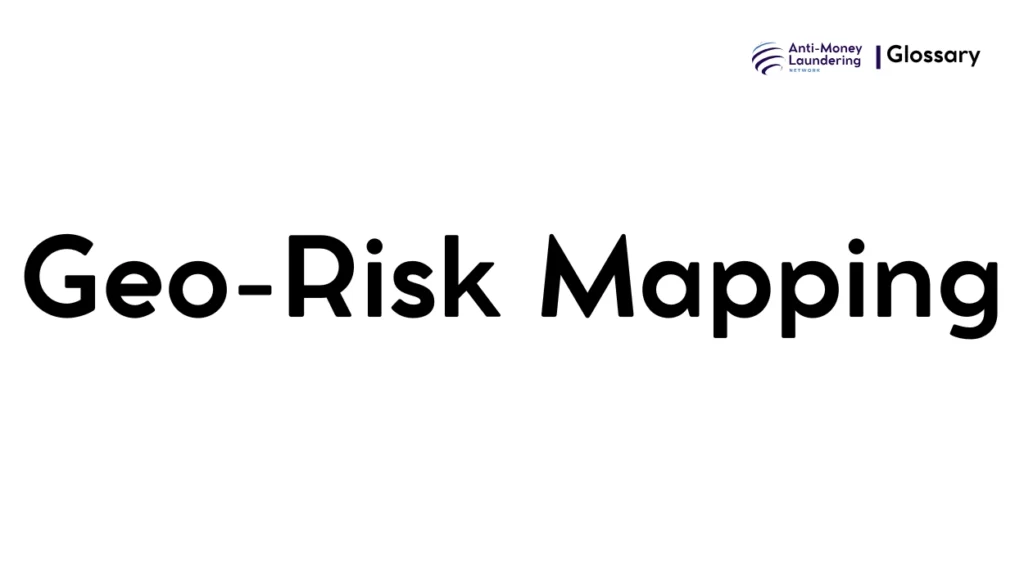Definition
Geo-Risk Mapping in Anti-Money Laundering (AML) refers to the process of assessing and visualizing geographic or location-based risks associated with money laundering activities. It involves analyzing the geographic locations of customers, transactions, and counterparties to identify regions or countries that pose higher risks of money laundering or terrorist financing. This process helps financial institutions evaluate the potential vulnerability of certain geographies to illicit financial activities and supports enhanced monitoring and due diligence efforts.
Purpose and Regulatory Basis
The primary purpose of geo-risk mapping is to assist financial institutions in identifying and mitigating geographic risks within their AML compliance frameworks. Recognizing that transactions involving high-risk jurisdictions or locations with weak AML controls present greater money laundering risks, geo-risk mapping enables institutions to adopt a risk-based approach in monitoring and managing these risks.
Key global and national regulatory frameworks emphasize this risk-based approach, including:
- Financial Action Task Force (FATF) Recommendations, which require countries and institutions to assess geographic risks and apply enhanced due diligence for high-risk jurisdictions.
- The USA PATRIOT Act mandates increased scrutiny of transactions involving foreign entities and regions identified as high risk.
- The European Union’s Anti-Money Laundering Directives (AMLD) stress geographic risk assessments as an integral part of customer due diligence and ongoing monitoring.
When and How it Applies
Geo-risk mapping is applied whenever financial institutions onboard customers or process transactions that involve geographic elements. Common triggers for geo-risk assessment include:
- Customers or transactions involving foreign countries, especially those classified as high-risk or non-cooperative jurisdictions.
- Cross-border transactions that could be linked to jurisdictions known for financial secrecy, corruption, or terrorism financing.
- Relationships with politically exposed persons (PEPs) from certain locations.
Using geographic data, institutions can detect suspicious patterns such as high volumes of transactions from specific regions or unusual geographic transaction flows, prompting enhanced due diligence or investigations.
Types or Variants
Geo-risk mapping can be classified by the scope and method of geographic risk evaluation, including:
- Country-Level Risk Mapping: Identifying risks based on countries’ AML regulatory quality, corruption levels, and involvement with illicit activities.
- Regional or Localized Risk Mapping: Analysis of specific regions or cities within countries known for money laundering hotspots.
- Transaction Flow Mapping: Visualizing the geographic routes of funds to spot suspicious cross-border movements.
- Real-Time Geo-Risk Analytics: Using geospatial data and GIS tools for continuous monitoring and anomaly detection across locations.
Procedures and Implementation
Effective geo-risk mapping implementation involves several steps:
- Data Collection: Gather geographic data related to customers’ residence, beneficial ownership, transaction origination, and destination points.
- Risk Scoring: Utilize regulatory lists (e.g., FATF high-risk country lists), corruption indices, and internal risk intelligence to rate geographic risk levels.
- Integration with AML Systems: Incorporate geospatial analytics and Geographic Information Systems (GIS) into AML transaction monitoring platforms.
- Risk-Based Controls: Apply enhanced due diligence for customers or transactions linked to high-risk areas, including additional verification and ongoing monitoring.
- Reporting: Document findings and escalate suspicious activities related to geographic risks in Suspicious Activity Reports (SARs) when warranted.
Impact on Customers/Clients
From a customer perspective, geo-risk mapping may result in:
- Additional scrutiny or verification if they are associated with high-risk areas.
- Possible transaction restrictions or delays when dealing with counterparties in high-risk geographies.
- Transparent communication regarding compliance measures while respecting customers’ rights to fair treatment.
Institutions must balance thorough risk assessment with customer service and data privacy to ensure compliance without unnecessary barriers.
Duration, Review, and Resolution
Geo-risk mapping involves continuous risk assessment:
- Geographic risk ratings should be reviewed regularly, especially after updates from regulatory bodies or geopolitical changes.
- Customer and transaction risk profiles need ongoing review to reflect new data or suspicious activity indicators.
- Institutions must update their AML programs and controls to address any changes in geographic risk assessment.
- Resolutions may include terminating relationships or blocking transactions linked to unmitigable high-risk areas.
Reporting and Compliance Duties
Financial institutions bear the responsibility to:
- Maintain detailed documentation of geo-risk assessments and decisions.
- Report suspicious activities related to geographic risk to appropriate regulatory bodies.
- Comply with audits and regulatory examinations on AML geo-risk controls.
- Understand the penalties for failing to adequately assess or mitigate geographic risks, which may include fines or operational restrictions.
Related AML Terms
Geo-risk mapping is intricately connected to:
- Customer Risk Profiling: Integrating geographic risk into overall customer risk scores.
- Enhanced Due Diligence (EDD): Additional checks based on geographic risk.
- Transaction Monitoring: Filtering transactions involving high-risk jurisdictions.
- Sanctions Screening: Identifying and blocking transactions tied to sanctioned countries or entities.
Challenges and Best Practices
Common challenges include:
- Accurate data collection and maintaining up-to-date geographic risk information.
- Balancing false positives versus detecting true risks from geographic data.
- Integrating geospatial analytics with existing AML systems.
Best practices to address these challenges: - Use multiple data sources including global regulatory lists and local intelligence.
- Leverage advanced geospatial and machine learning tools for better detection accuracy.
- Regularly update geographic risk frameworks to reflect geopolitical shifts and emerging threats.
Recent Developments
Innovations driving geo-risk mapping forward include:
- Real-time geospatial analytics integrated with AI to detect suspicious financial flows instantly.
- Cross-sector collaborations for sharing geographic risk intelligence.
- Increasing regulatory focus on geographic risk, including updates in FATF recommendations and EU AMLD enhancements.
- Privacy-preserving data mining techniques to reconcile geographic risk monitoring with data protection laws.
Geo-Risk Mapping in AML is a critical tool enabling financial institutions to assess, visualize, and mitigate money laundering risks associated with specific geographic locations. Grounded in regulatory requirements like those from FATF, the USA PATRIOT Act, and EU AMLD, it supports a risk-based approach to AML compliance by enhancing detection accuracy and enabling targeted controls. Through continuous updates and the integration of advanced geospatial technologies, geo-risk mapping remains vital in the fight against illicit financial activities.

